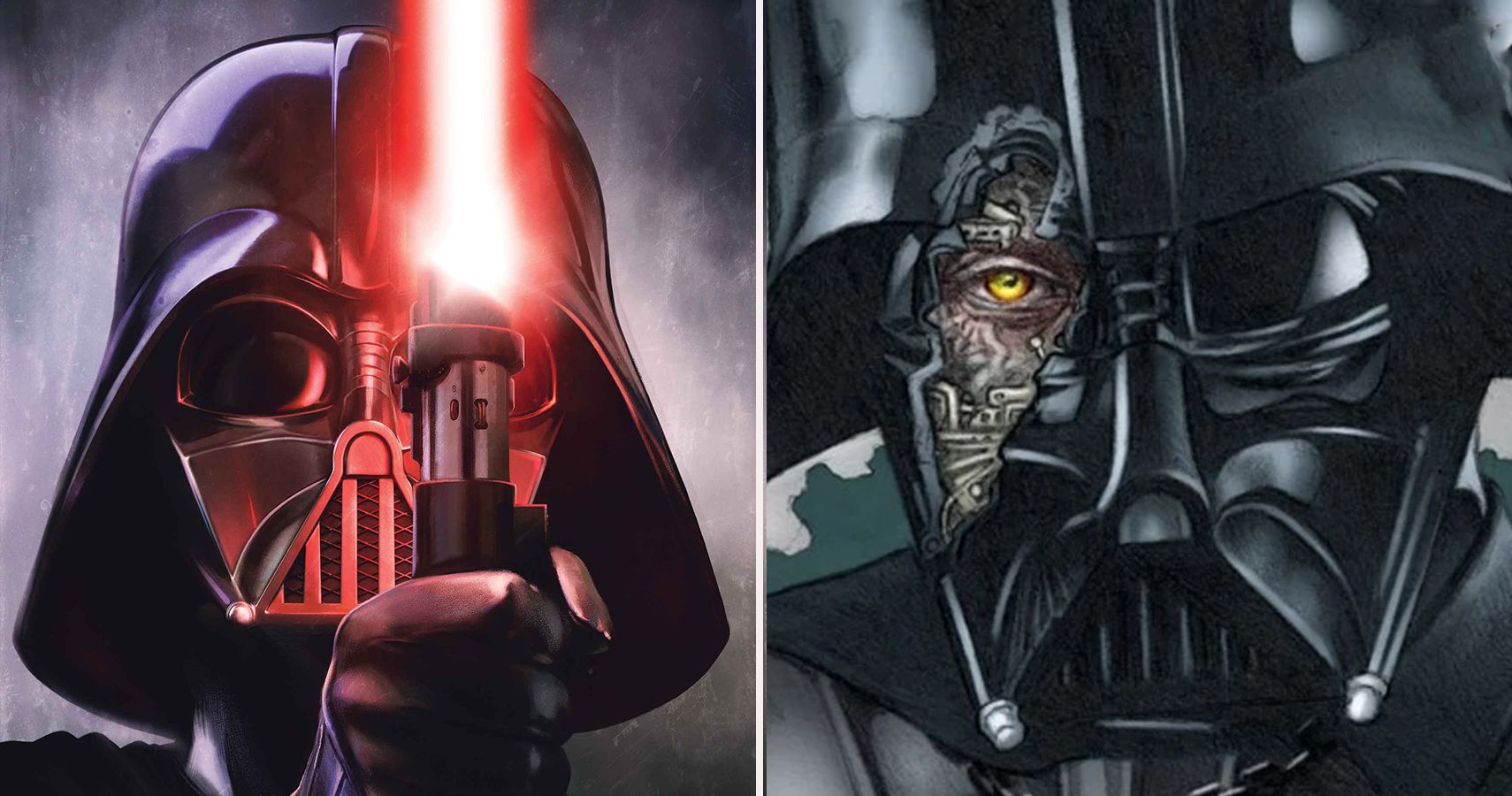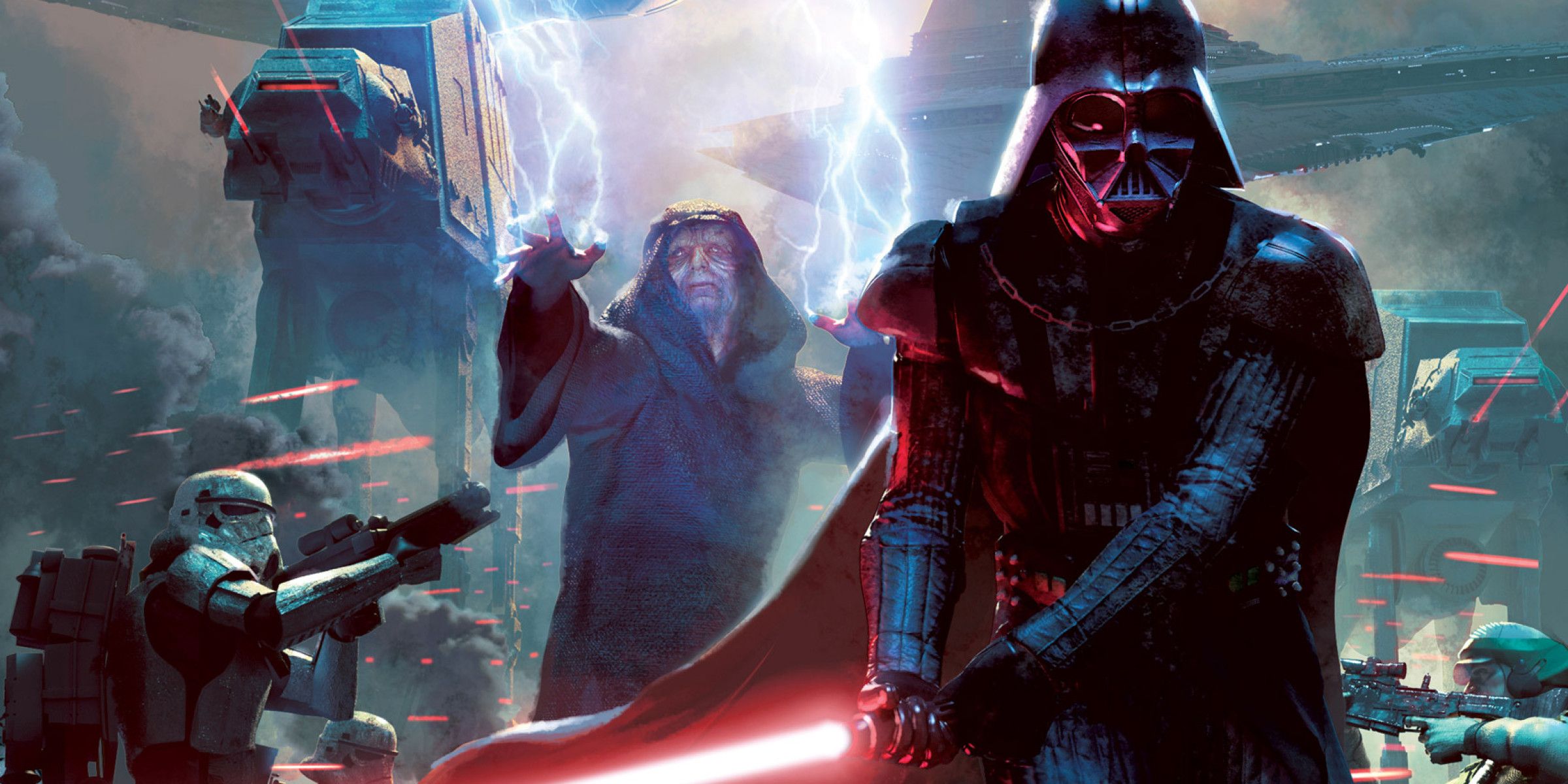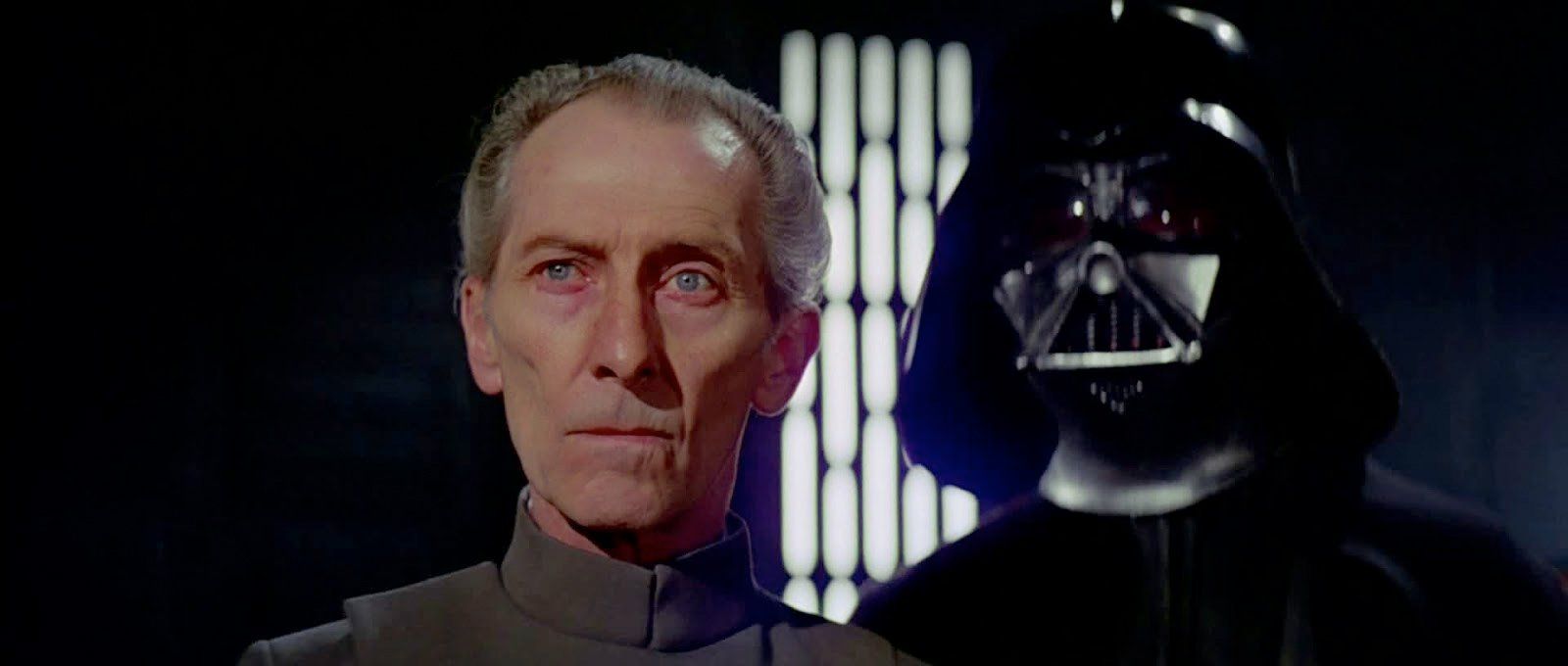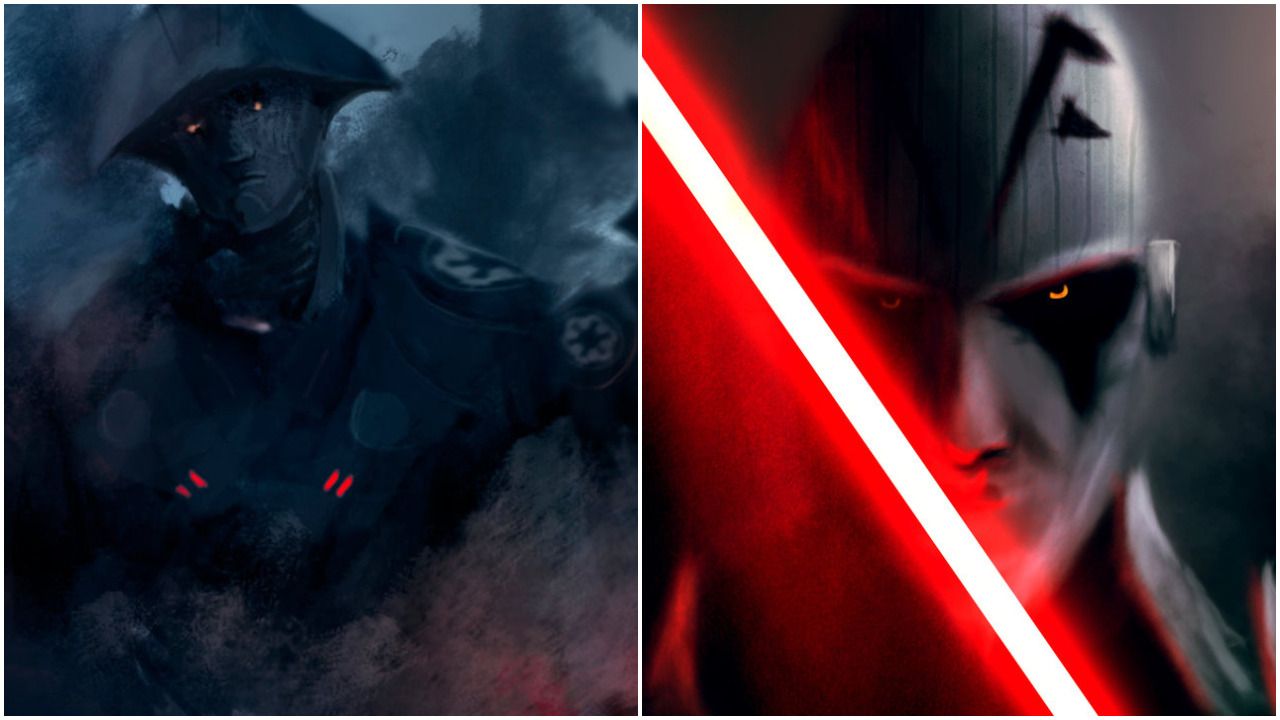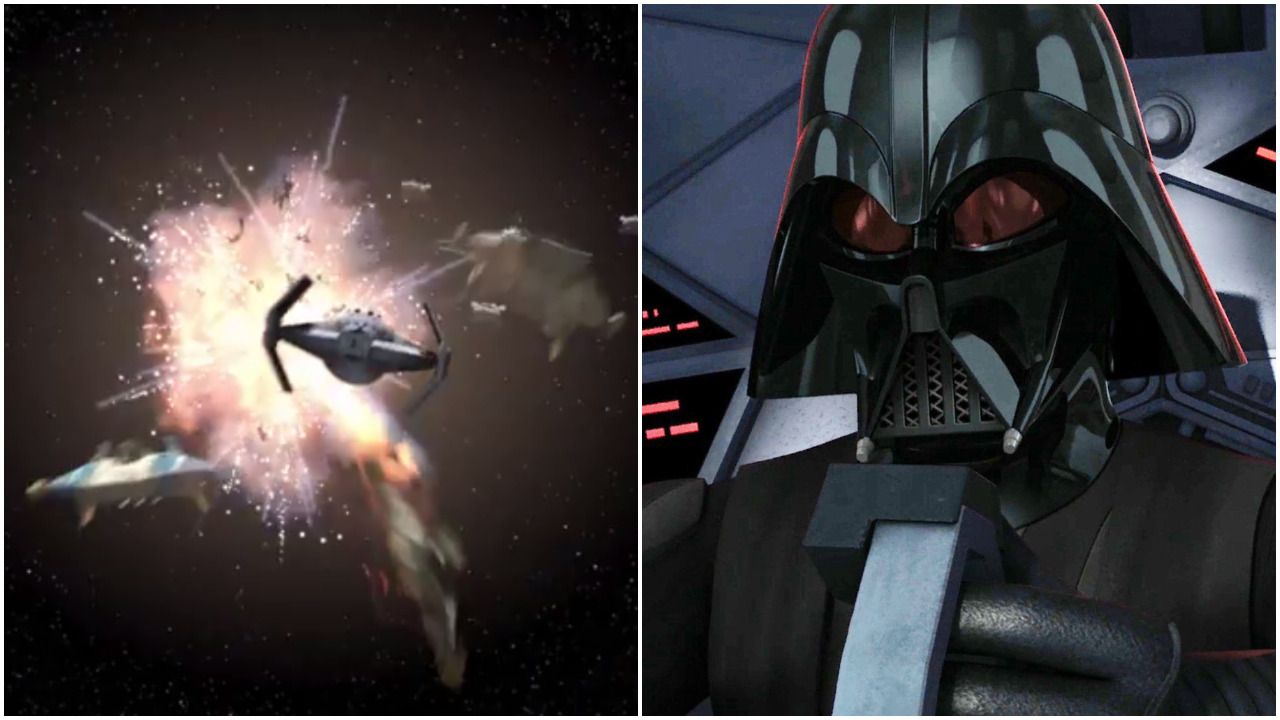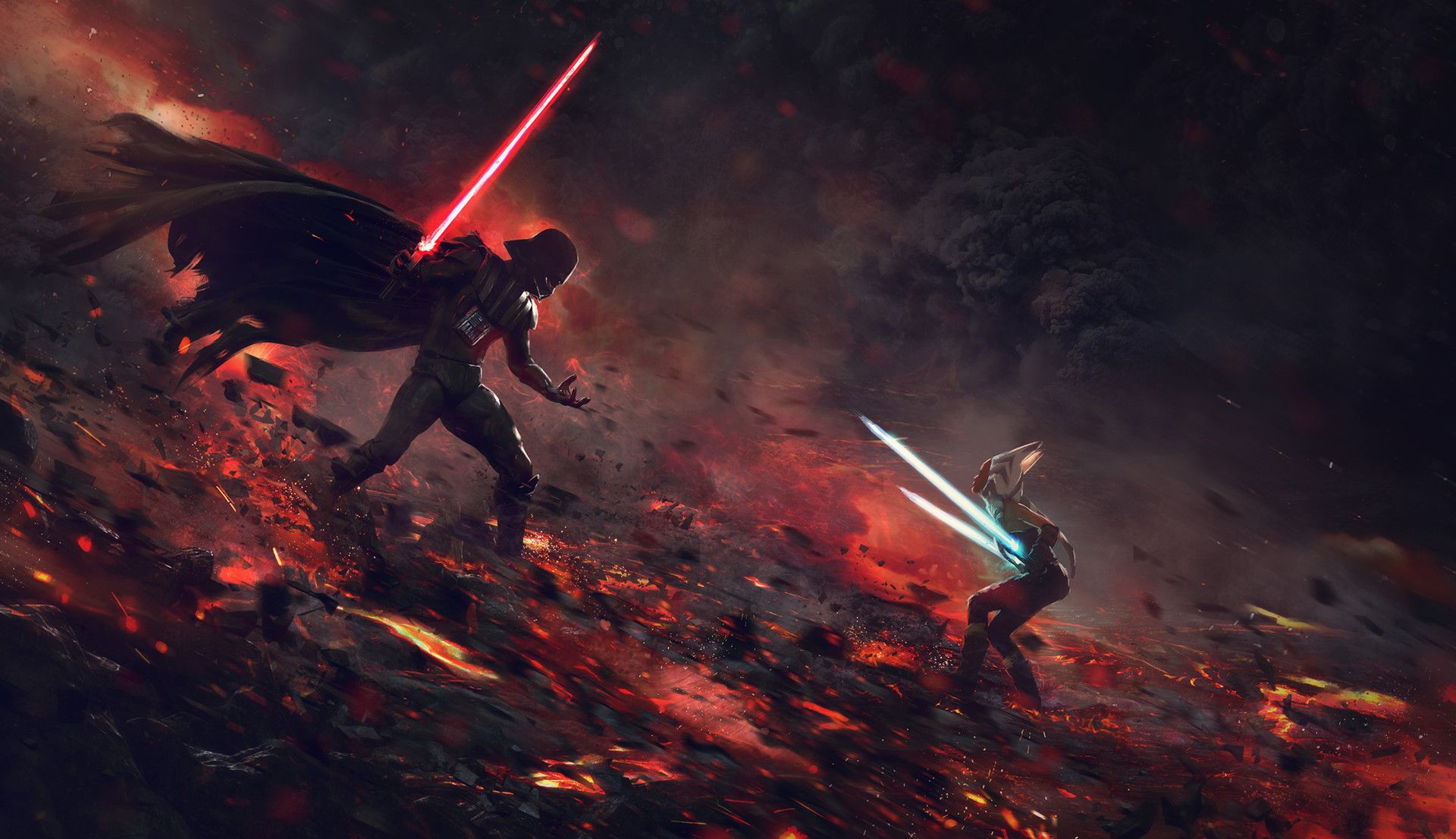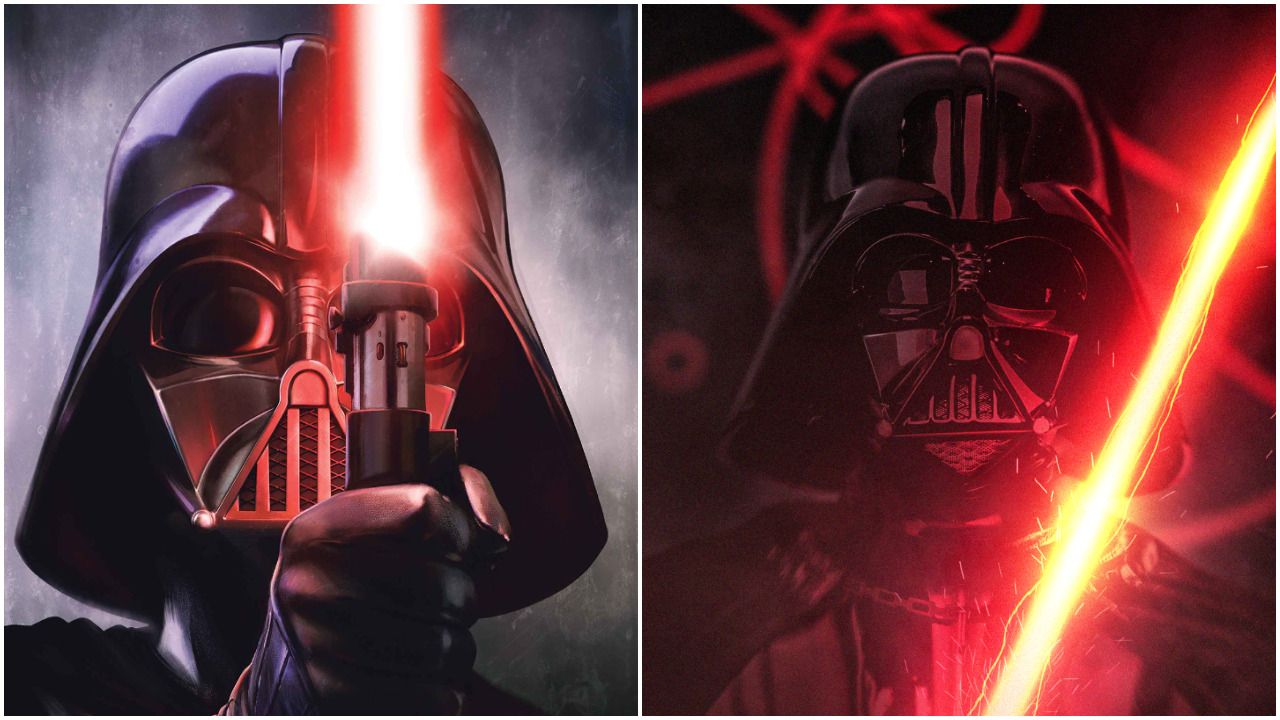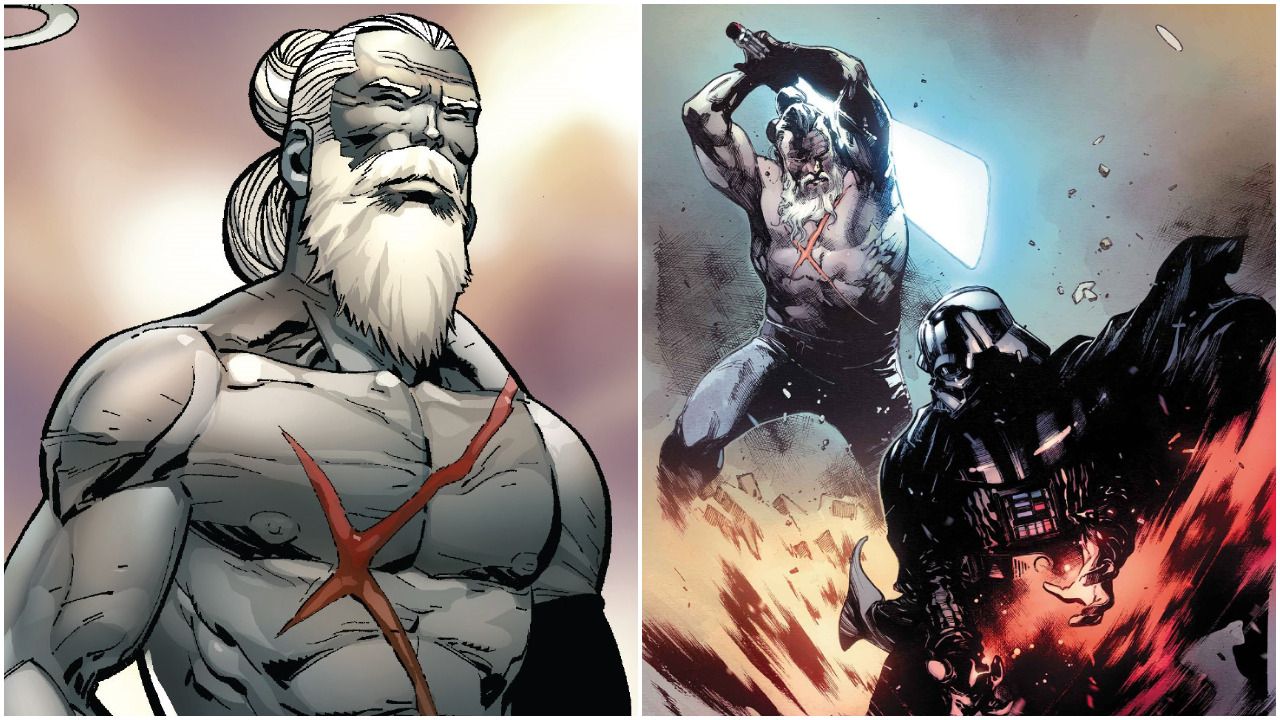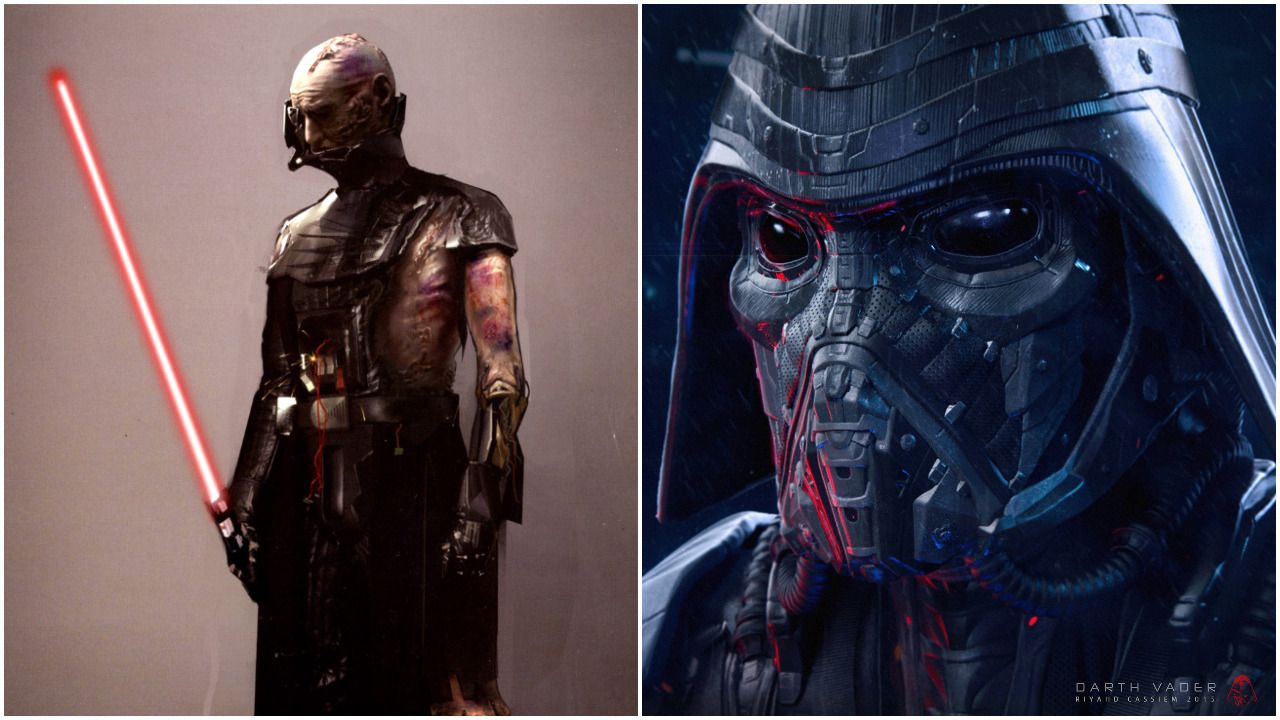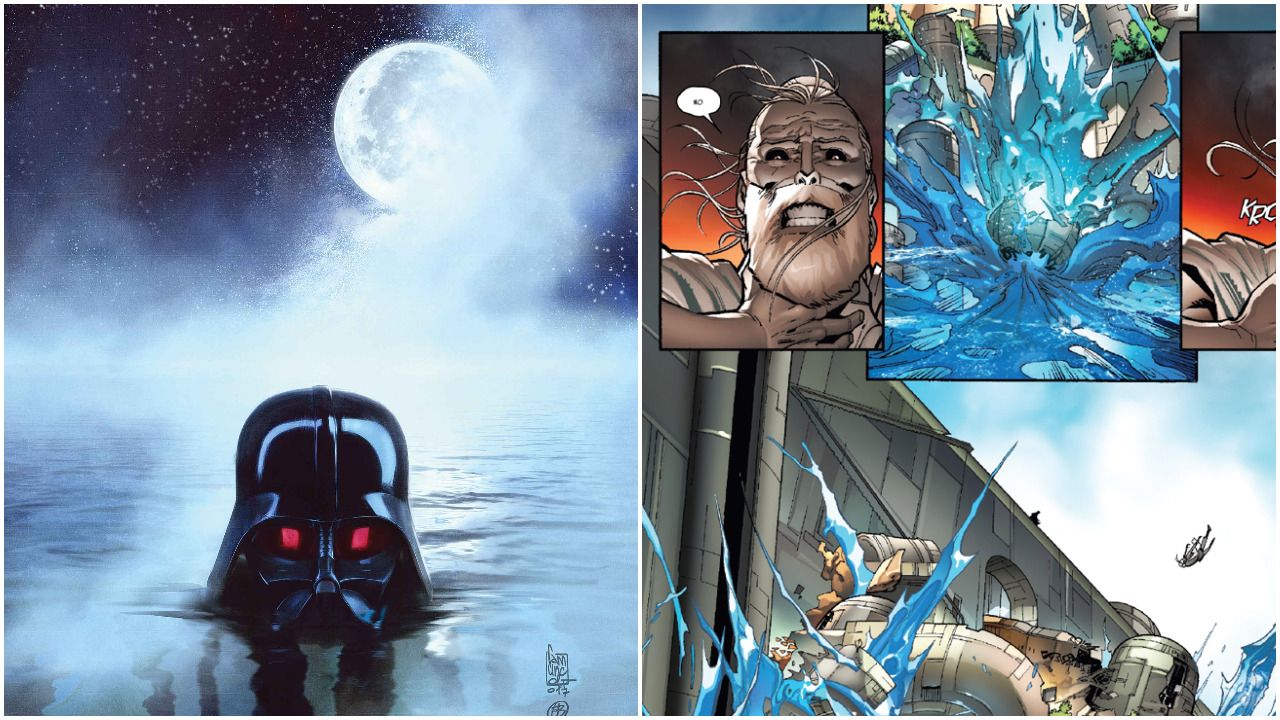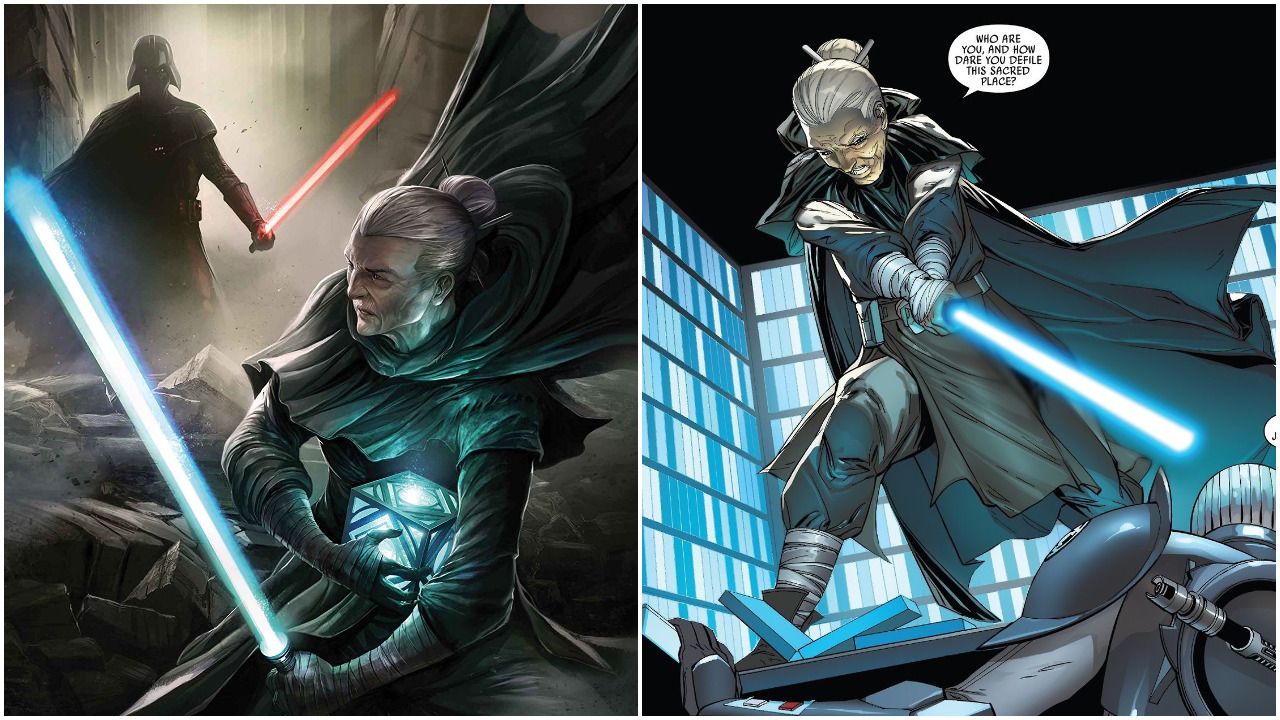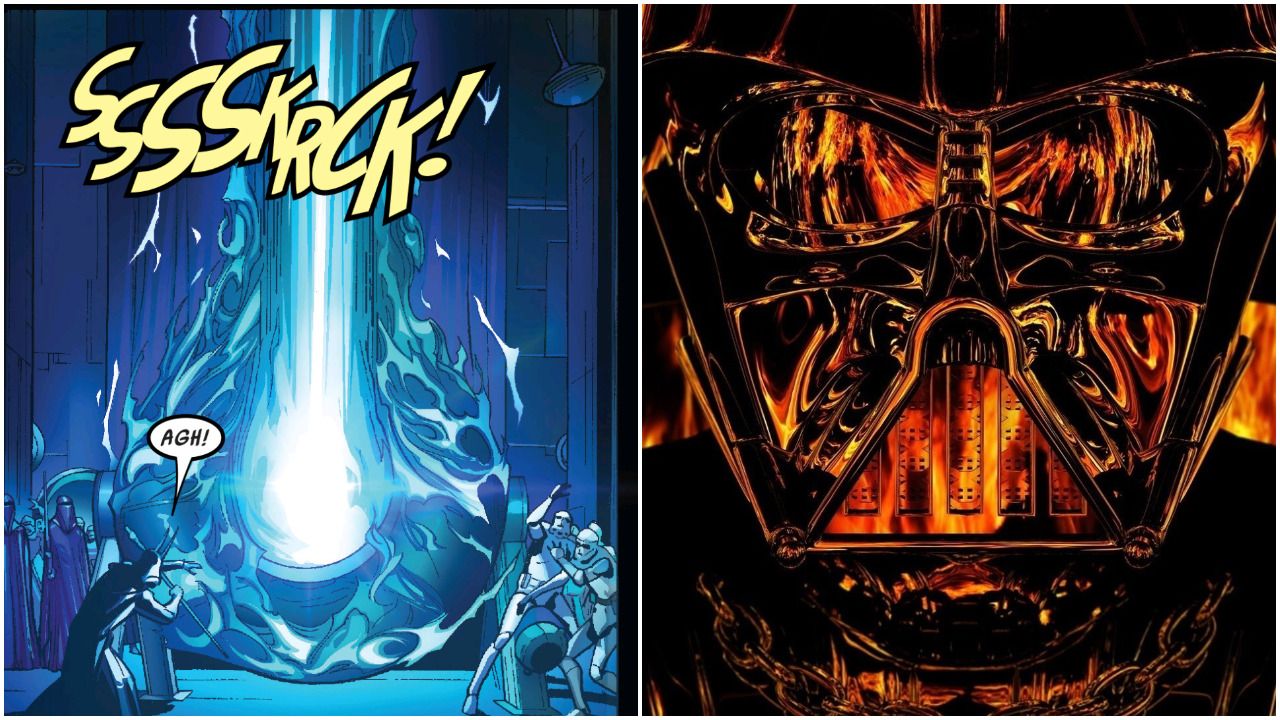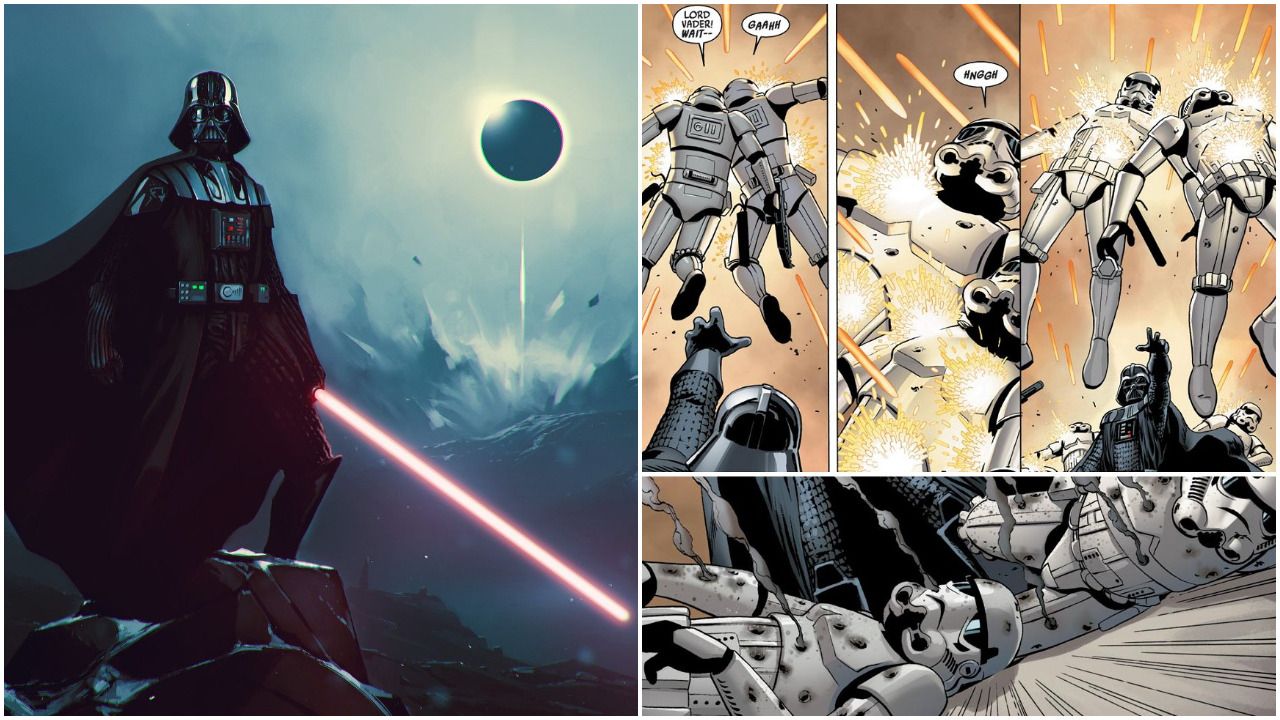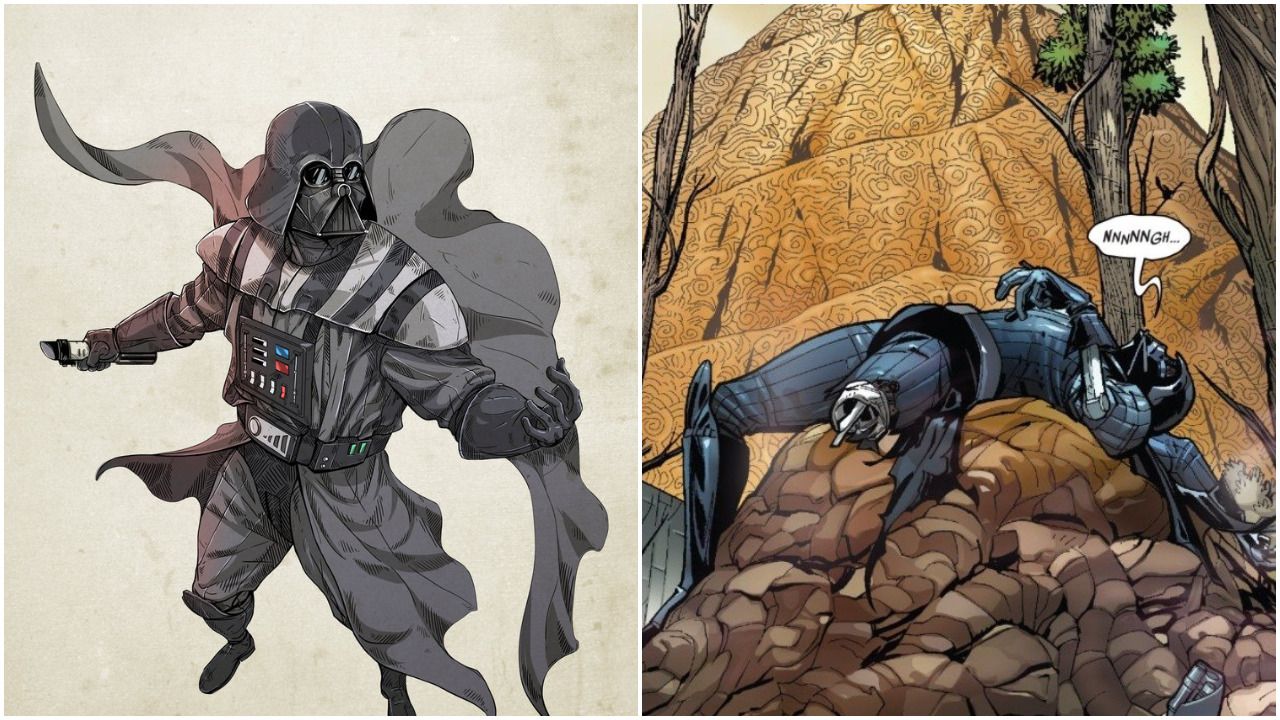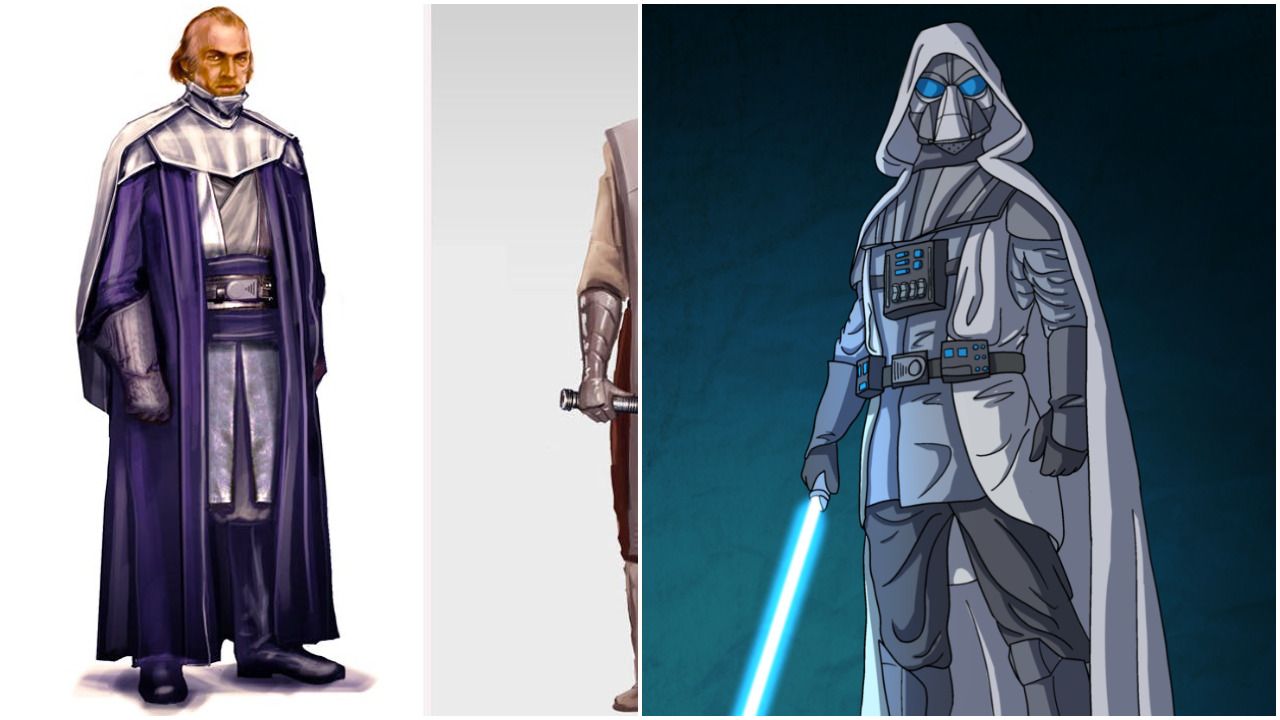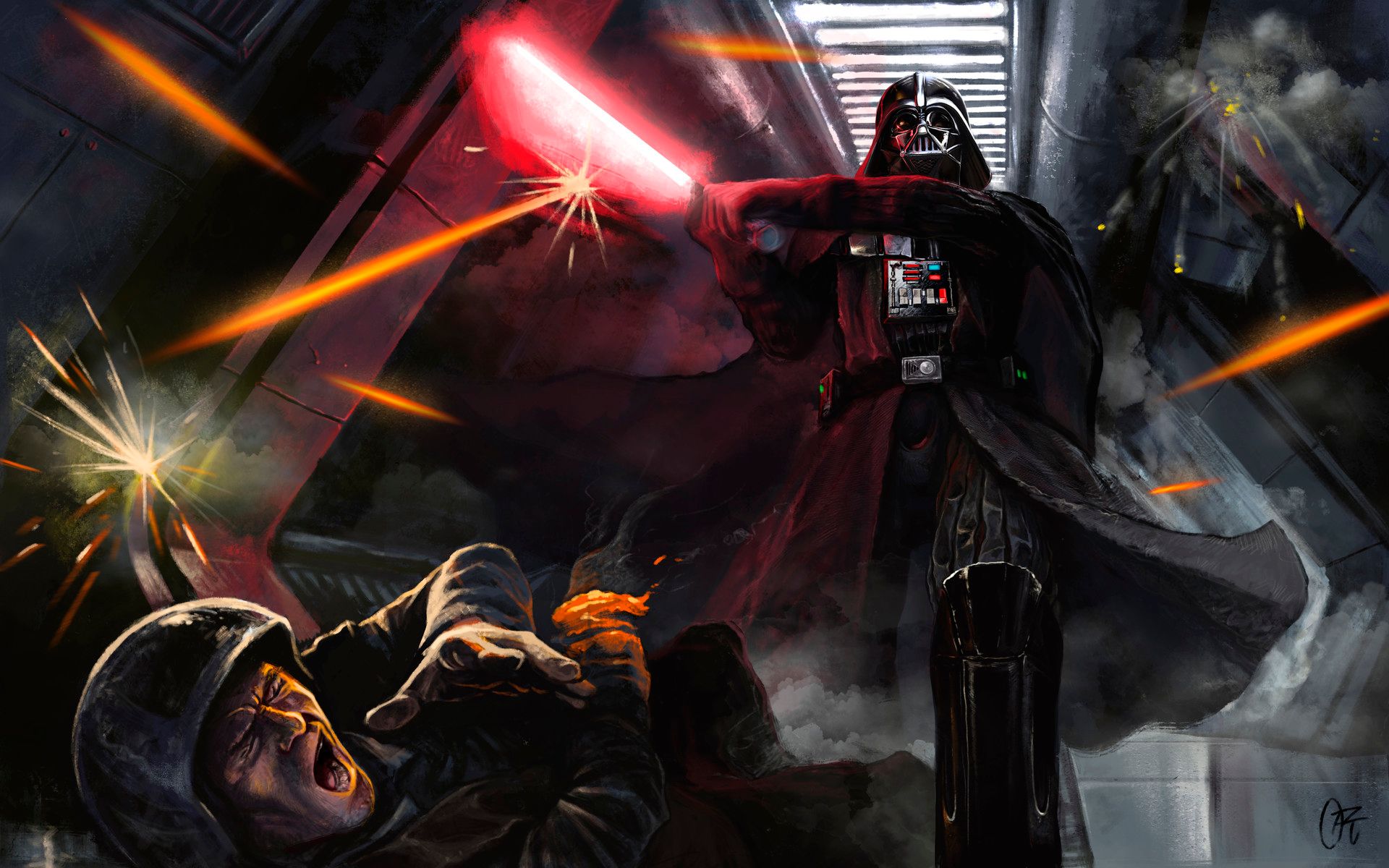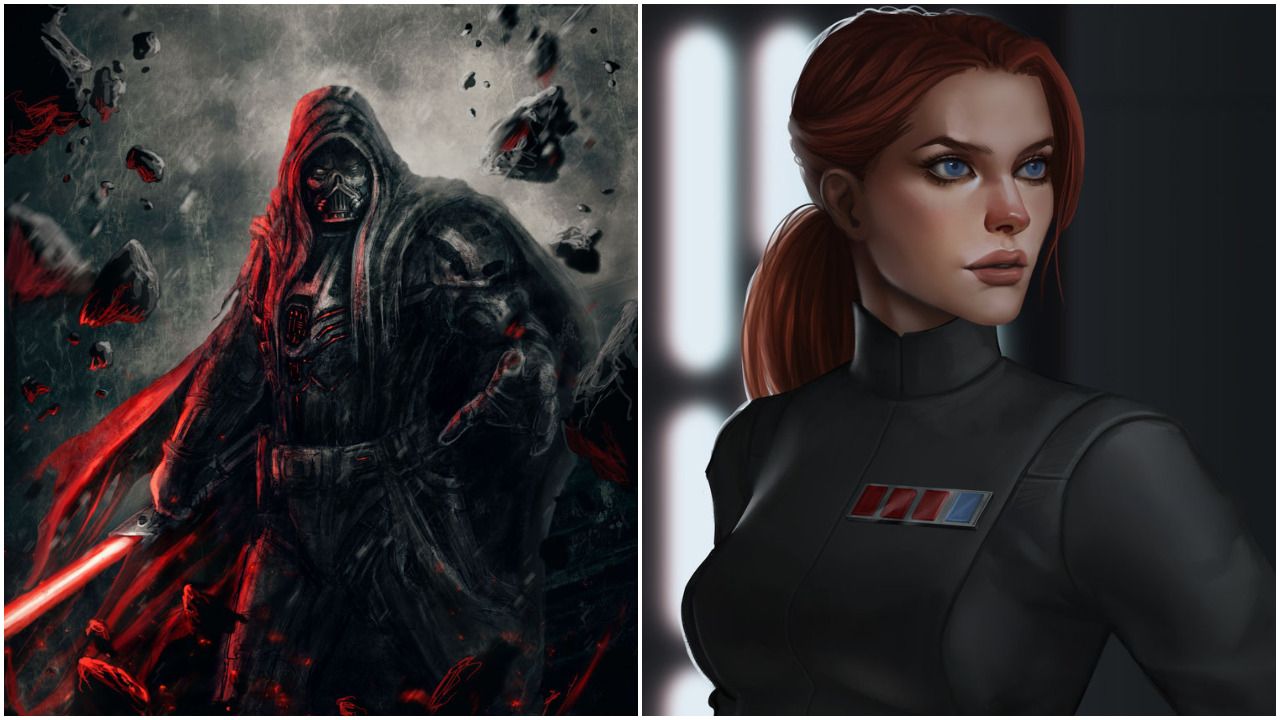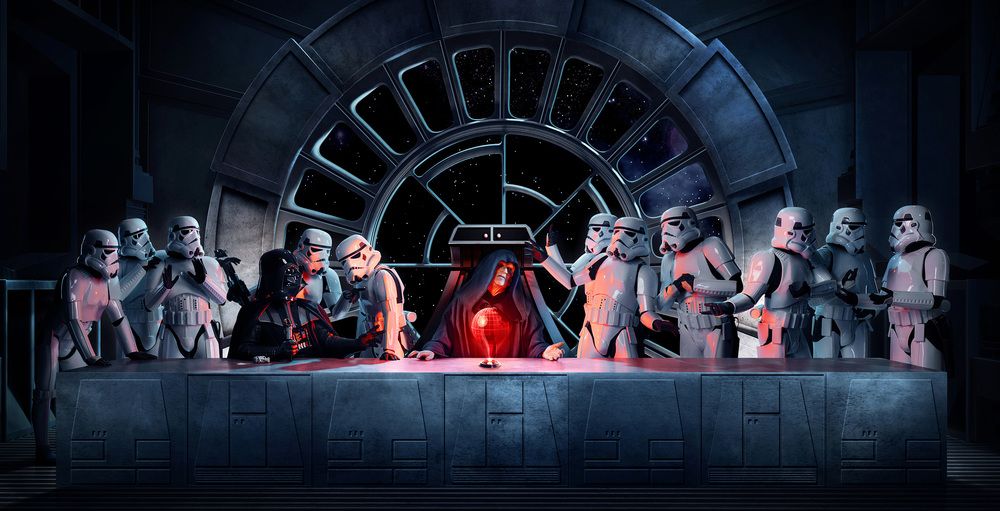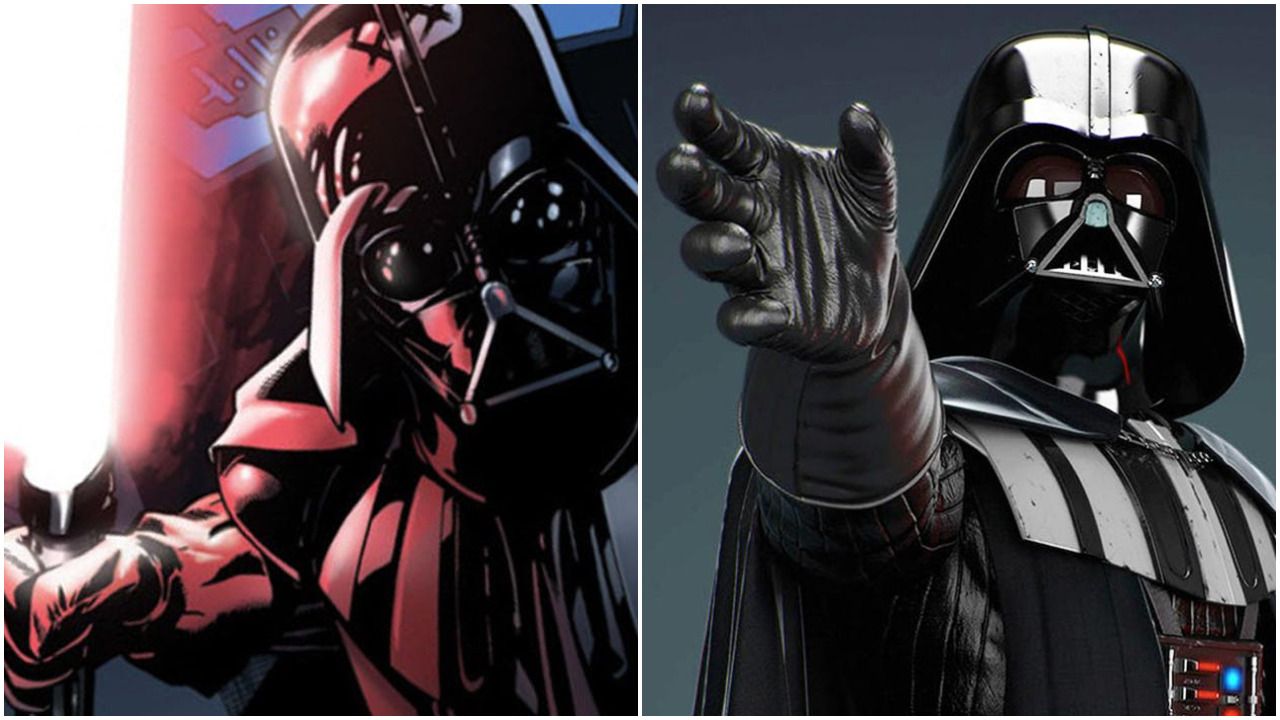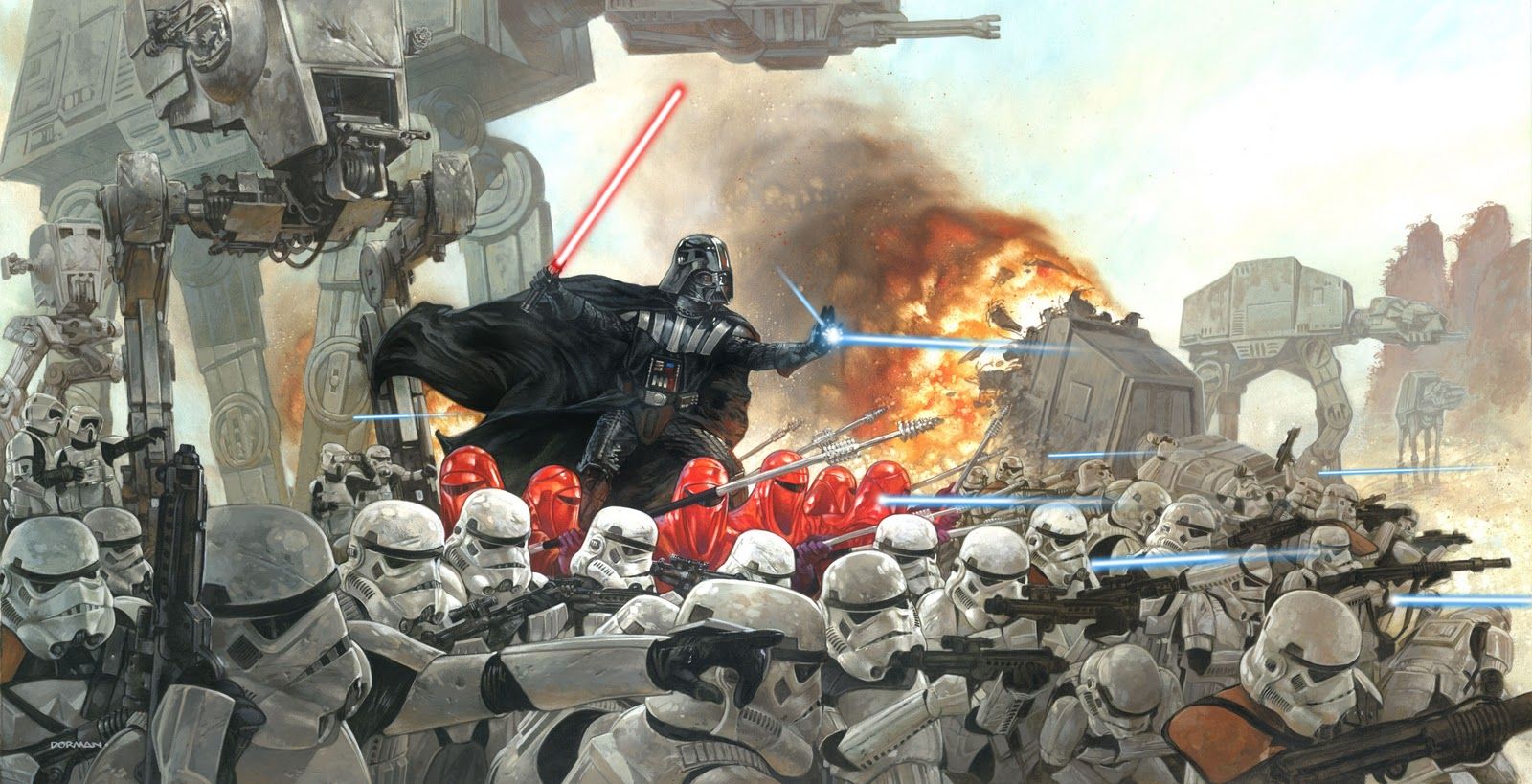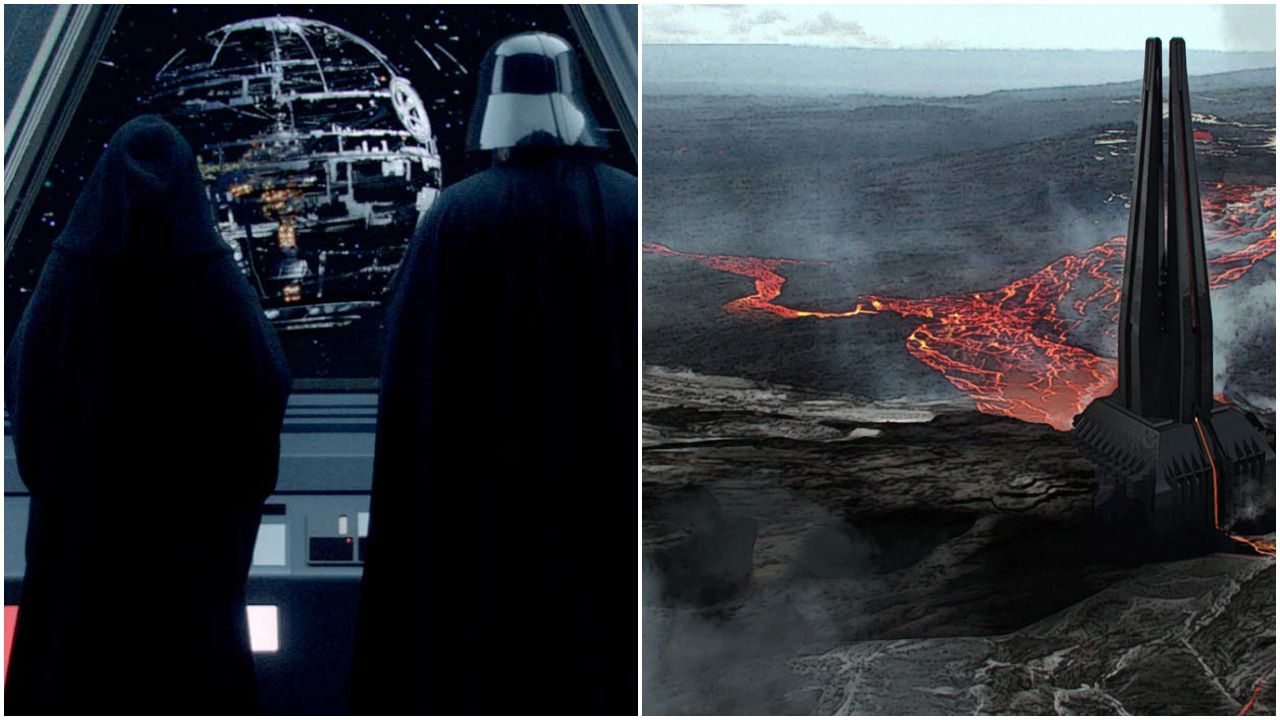Darth Vader is such an iconic symbol of evil and power that Star Wars has made him it's unofficial mascot. There is perhaps no more evocative single image from a franchise full of memorable designs that evoke more of an immediate reaction than that cold, sleek, black, samurai-inspired helmet. Voted the best villain of all time, out of 100 competitors, by IGN.
An argument could be made that Darth Vader is the real main character of the Star Wars films. He is certainly the most important character in most of the film episodes, and a lot of screen time is devoted to discussing him in a sort of Sith-focused Bechdel Test. With Star Wars recreating its truth and canon from whole cloth, there is now a major gap in Darth Vader's story, one that has been steadily filled in over the last few years and has some truly awesome moments in the early days of Anakin Skywalker fully accepting his role as the Empire's Hand.
From the moment he screams "NO" to staring off as the Tantive IV escapes with the Death Star plans, comic book writer Charles Soule, novelists Paul S. Kemp & James Luceno, and Dave Filoni's team on Star Wars: Rebels, have started to fill in the grey space between Episode III and IV. If you wanted to know how Vader got his red lightsaber, or when he switched to flying the TIE Advanced prototype, to when he first revealed himself to the Empire and the galaxy at large, keep reading.
Big, huge thanks to whoever maintains the Anakin Skywalker Wookieepedia page, an essential resource for seeing the major beats of Vader's journey between the films.
25 Sith Bros
One thing we never go to see in the films was Vader and Palpatine tearing things up around the galaxy. Vader was always the one striding around in his big black cape, slicing up dudes with his lightsaber, while Palpatine only gets to cut loose briefly in Revenge of the Sith and Return of the Jedi. We all owe a big thanks to writer Paul S. Kemp for finally giving us the buddy cop drama we always wanted from D. Vades and The Palp.
Luckily, Palpatine doesn't bust out his ridiculous spinning lightning attack.
Lords of the Sith is a novel that takes place between the end of the prequel trilogy and the beginning of the Rebels TV show. Palpatine and Vader are both stranded on the Twi'Lek home planet of Ryloth where they proceed to just wreck so, so many people. Highlights of Lords of the Sith include Vader being a complete beast and the appearance of Cham Syndulla, aka the father of Hera from Rebels. Ryloth has made a number of appearances in the new canon, which is awesome because the Twi'Lek's have always been a staple of Star Wars but their history and culture have been neglected.
Source: Star Wars: Lords of the Sith by Paul S. Kemp, published by Del Rey
24 Larkin With Tarkin
In the new canon, Moff Wilhuff Tarkin has gone from being the skeleton-faced boss of the Death Star to a major player in Star Wars, appearing as the governor of Lothal in Rebels, in full-CGI resurrection in Rogue One, and getting his very own novel in James Luceno's Tarkin.
Vader is very much a supporting character in Tarkin but we get some cool moments from the two Imperial heavies. Tarkin first sees Vader meeting with a bunch of crime lords in the ruined Jedi Temple, ordering them to relocate their operations elsewhere. After Vader crushes someone's heart with the Force, Tarkin admonishes him for ending everyone who makes him angry, in a nice call-forward to A New Hope. Tarkin and Vader spend most of the book rooting out a small insurgency and planting the seeds for their eventual collaboration on the Death Star in ANH. The insurgency is eliminated with the usual Imperial ruthlessness: Vader tells Tarkin in the last chapter that everyone who helped the insurgency: the factory workers, shipbuilders, and scientists had all been "punished", which probably means ended horribly. Tarkin is a cool book and sets the ground rules for the Tarkin Doctrine, which is the in-universe explanation for why the Empire is obsessed with hideous super weapons and enormous starships.
Source: Tarkin by James Luceno, published by Del Rey
23 Opens A School For Underprivileged Sith
One of the best creations of the Rebels TV series is the revelation that not only were there other Force-using characters working for the Empire, but that Vader and the Emperor used them to hunt down those that had survived Order 66. The Inquisitorious was formed by the Emperor who trained all their members to seek out not only former Jedi but also new Force-sensitive citizens and soldiers of the Empire. Vader actually encountered the first Inquisitor, the Grand Inquisitor, in the ruins of the Jedi Temple where the Notorious GI had been a Jedi Temple Guard, those masked Jedi with gold sabers from the Clone Wars TV Series. The Grand Inquisitor had even been involved in arresting Ahsoka Tano, which would lead to her leaving the Order before the Purge and allowing her to help the Rebel cell Phoenix Squadron.
The Inquisitors wield unique red double-bladed lightsabers whose hilt is a ring that allows the blades to be spun very quickly, like a circular saw blade. Despite their fearsome appearance and reputation, the Inquisitors were often bested by the superior training of the Jedi. Vader had a lot on his plate in addition to training the Inquisitors, after all. Even the Grand Inquisitor was defeated by the Ezra Bridger.
Source: Star Wars: Darth Vader: Dark Lord of the Sith by Charles Soule, published by Marvel Comics; Star Wars: Rebels TV Series, created by Dave Filoni, Star Wars: The Clone Wars developed by Dave Filoni
22 Is A Total Boss In The Cockpit
Somewhere in the new canon, Vader swaps out the ETA-2 Interceptor he had flown as Anakin Skywalker (Painted black because Empire), For his fancy TIE Advanced X1 prototype which he would use so effectively in A New Hope. While the dogfighting in A New Hope is limited by the technology of the time, we get to see the X-1 in full form in the second season of Rebels.
After luring the Lothal cell into stealing a shuttle, Vader tracks them to the rest of their small fleet and ambushes them. Vader engages the Corvette Phoenix Home, the Ghost, and a squadron of A-Wings all by himself, decimating the fighters and severely damaging the Corvette without taking a single hit himself. The TIE Advanced displays some pretty wild maneuverability that we hadn't seen before in Star Wars starfighters. In one particular moment of the battle, Vader flips his TIE around and allows it to drift backward while firing at his pursuers, Battlestar Galactica-style. The only reason Vader doesn't completely wipe out Phoenix Squadron is a momentary hesitation brought on by a mental connection with Ahsoka Tano, who was on the bridge of the Phoenix Home.
Source: Star Wars: Rebels TV Series, created by Dave Filoni
21 Duels!
That moment of connection between Vader, or Anakin as the case may be, and Ahsoka Tano is the first time either had realized the other was still alive. Thus, in the second episode of season two of Rebels, there begins a race to a confrontation that had been anticipated since it was first announced that Ahsoka would appear in Rebels: a showdown between Vader and his former apprentice.
It takes until the end of the season, in an episode considered by many to be one of the highlights of the whole show. The Vader and Ahsoka duel does not disappoint. Wielding dual blades of silvery white, Tano keeps Vader occupied long enough for Ezra and Kanan to escape. Tano succeeds in slicing Vader's helmet, allowing the two old friends to make eye contact and giving us the chilling experience of hearing Anakin's old voice underneath the metallic vocalizer of Vader's helmet. Vader's fighting style in this battle is really well done, a combination of his acrobatic style in Clone Wars and the brutal, single-handed-hacking we see him use in the original trilogy, easily batting away Ahsoka's athletic strikes. As a lightsaber duel, it has more emotion than most of the fights in the series, especially if you've been following the Star Wars TV shows since Clone Wars.
Source: Star Wars: Rebels TV Series, created by Dave Filoni
20 Shiny New Saber
If you're a fan of Star Wars you need to be up on the new Marvel comics series. Not only are they filling in the new canon by picking the best stuff from the old Legends Expanded Universe, they're telling some of the best Star Wars stories ever. The Darth Vader comic is awesome but it had a pretty hard endpoint: Vader's end in Return of the Jedi. Having reached that endpoint, writer Charles Soule is now exploring Vader's early years between Revenge of the Sith and Rebels.
Considering how important Anakin Skywalker's lightsaber is to Star Wars, it's amazing that no one had really explored how Vader made his red lightsaber. Palpatine essentially makes acquiring a new lightsaber Vader's first mission for the Empire, a way to test his new abilities and robot suit, and to cement Anakin's transformation into Darth Vader. After acquiring a Jedi lightsaber, Vader takes it to the planet where he created, Mustafar, where a Sith device will allow him to corrupt the kyber crystal inside. The Iocus, as the device is called, allows the Sith to 'bleed' the crystal and stain it red. The crystal fights back, granting Vader a vision of an alternate future, but Vader rejects the vision and pours his rage, anger, and pain into the crystal. He assembles a new lightsaber and uses it from then on.
Source: Star Wars: Darth Vader: Dark Lord of the Sith by Charles Soule, published by Marvel Comics
19 Darth The Bounty Hunter
But wait, how did he get that lightsaber? Palpatine's first mission for Vader was to hunt down and end a former Jedi, Kirak Infil'a, and take his lightsaber for himself. Although Vader was struggling with his new mechanical body, he didn't hesitate in tracking down Infil'a on the moon Al'doleem.
Infil'a was a combat expert, the rare Jedi who had focused on fighting with lightsabers and the Force at the expense of all other pursuits. Infil'a had taken the Barash Vow (more on that later) which forbade him from becoming involved in any matter of the Jedi Order's business as a form of penance. When Vader arrives on Al'doleem Infil'a challenges the Dark Lord to come and get him, retreating up the side of a mountain which he eventually tossed Vader right off the side of. Vader recovered from the fall and distracted Infil'a by playing the Jedi's great weakness against him. Vader threatened an entire city with demise and, while Infil'a was distracted, pulled the Master's lightsaber off his belt using the Force. Reveling in his triumph over the Jedi Master, Vader didn't even end him with his own blade: Vader lifted him up with the Force, crushed his throat, and tossed him aside.
Source: Star Wars: Darth Vader: Dark Lord of the Sith by Charles Soule, published by Marvel Comics
18 He's A Gearhead
His pursuit of Infil'a wasn't so simple. While charging up the side of the mountain to confront the former Master, Vader was constantly harassed by Infil'a's training droids. While Vader was able to easily destroy most of them, one of Infil'a's training droids used an unconventional tactic. The droid unleashed a river which crashed into Vader and severely damaged one of his robotic legs, weakening the knee joint. While Vader destroyed that droid too, when he made it to the top of the mountain he was significantly handicapped for a fight against a combat expert. Infil'a battled Vader long enough for the damaged leg to become a liability, which it did by shattering at the knee. Vader was tossed off the side of the mountain and believed deceased.
Remember when he made C-3P0?
Whether a combination of the Force, his new robotic body, or his own indestructible will, Vader survives the fall. Upon waking, Vader found the droid that had dumped the river on him and set to work. Recalling all those times he had slaved away in Watto's junkyard as a boy, putting those droid-building skills to work, Vader used the parts of the destroyed droid to repair and reinforce his busted leg.
Source: Star Wars: Darth Vader: Dark Lord of the Sith by Charles Soule, published by Marvel Comics
17 A Bad Lifeguard
We know that Vader is ruthless. In the films, we see him eliminate younglings (well, we don't see it but it's very heavily implied). And while he doesn't give the order to destroy Alderaan, he definitely doesn't do anything to stop Tarkin from doing it. Charles Soule's Vader comic gives us plenty of new reasons to fear the Dark Lord, especially in the way he uses the demise of innocents to get what he wants.
After scrapping a droid to repair his broken leg, Vader pursues Master Infil'a to the top of a dam where they continue to battle. Remember earlier when I said that Vader used the Jedi weakness for defending innocents? While Vader and Infil'a battled on the dam, a group of security guards tried to intervene. Vader used the Force to throw them off the dam, and Infil'a saved them. He also learned a lesson in unconventional warfare just earlier that day. Tired of the stand-off, Vader attempts to flood the nearby city by destroying a giant water storage tank, forcing Infil'a to stop their duel to use the Force in an attempt to stop the deadly flow of water. Vader grabs Infil'a with the Force and subjects the Master to watching the city be destroyed in the flood before ending him.
Source: Star Wars: Darth Vader: Dark Lord of the Sith by Charles Soule, published by Marvel Comics
16 Returned A Library Book
A small but memorable scene in Attack of the Clones belongs to Jedi librarian Jocasta Nu, who arrogantly rebuffs Obi-Wan Kenobi's investigation into the planet Kamino by declaring that if a planet is not in the Jedi Archive, then it must not exist. While the scene in Episode 2 does a great job setting up the arrogance of the Jedi, there is a lot more to Jocasta's character in the Clone Wars series and the comics.
Jocasta had evaded Order 66 and immediately set about preserving the Jedi teachings, just as she had while still employed by the Order. While she had managed to gather a number of holocrons and kyber crystals, she needed to launch one more mission. Jocasta sneaks back into the Archive on Coruscant for one reason: to seize or destroy a kyber crystal which contains a list of all the Force-sensitive children known to the Jedi at the time of the Jedi Purge. She is interrupted by the Grand Inquisitor and Vader and is captured by the latter. She tries to turn Vader's clone troopers against him by telling them he is Anakin Skywalker, so Vader ends them all to keep his secret safe. After eliminating Jocasta, Vader destroys the crystal, ensuring Palpatine will not be able to train any other apprentices.
Source: Star Wars: Darth Vader: Dark Lord of the Sith by Charles Soule, published by Marvel Comics
15 He Went To A Bonfire
Through a series of political manipulations that aren't super well explained in Revenge of the Sith, Chancellor Palpatine is able to justify the eradication of the Jedi by using Mace Windu's attack on him as evidence of Jedi corruption and desire to overthrow the civilian government. After his transformation in Vader, Palpatine took the newly cyborg Anakin Skywalker to a view of the old Jedi Temple. Mas Amedda, the chancellor of the Republic who was now and had always been a puppet of Palpatine, was holding a ceremony that the Emperor wanted his new partner to see with his own eyes.
Less of a "celebration" and more of a "terrifying fascist rally."
The Celebration of the Eradication of the Jedi, as it's called in the canon, was a symbolic destruction of the greatest symbol of Jedi power, their lightsabers. Having gathered all the lightsabers of the Jedi who had been eliminated in the sacking of the Jedi Temple, Amedda had troopers toss their blades into a giant fire. Amedda himself tossed Yoda's small blade into the flames. The kyber crystals of the lightsabers burst under the heat, sending a blast of blue light and energy into the sky.
Source: Star Wars: Darth Vader: Dark Lord of the Sith by Charles Soule, published by Marvel Comics
14 Get Out Of His Way
Anakin Skywalker was famous for his abilities as a general and starfighter pilot. We see plenty of evidence in the Clone Wars series of his leadership qualities and the loyalty he inspires in his troops. It's not a stretch to say that Clone Wars does a much better job at showing the tragedy of Anakin's impending fall, despite that it ends up being underwhelming in Revenge of the Sith.
Maybe that's unfair. No, it isn't.
Whatever responsibility Anakin Skywalker may have had towards the clone troopers he had spent so much of his life leading and defending, Darth Vader possesses absolutely none of it. While pursuing the former Jedi Master Infil'a in an effort to secure a lightsaber for himself, Vader arrives at the Jedi outpost of Brighthome. Showing his trademark impatience, when the Clones hail Vader and ask for his clearance codes, he just ends all of them. To be one hundred percent clear, Vader has those codes. He has totally legitimate business on Brighthome: to search for Jedi who took the Barash Vow and may have escaped Order 66. It's like needing to print something at the library and, instead of showing them your card, you just crush everyone with your mind.
Source: Star Wars: Darth Vader: Dark Lord of the Sith by Charles Soule, published by Marvel Comics
13 Took A Vow
After slaughtering the loyal clone troops of Brighthome because they asked to see his bus pass, Vader learns of an obscure Jedi tradition called the Barash Vow, which we've talked about a bit already. The Barash Vow is an oath taken by Jedi who have done some disgrace to the Jedi, or who feel their purpose as a Jedi is unclear. Around 14,000 Jedi had taken the Vow since the founding of the Order thousands of years ago.
Honestly, seems like a good way to get the perks of the Jedi without the rules.
Charles Soule, the writer of Darth Vader: Dark Lord of the Sith, said that he created the Barash Vow as a way for him to have a reason why there would be a surviving Jedi that would be a believable combat challenge for the weaker Vader we see in this series. Infila is definitely a worthy match for Vader, tossing him off a mountain, constantly taunting him, and eventually making Vader realize that he can't defeat the Jedi at all. It's only by manipulating Infil'a's desire to help innocents, he is, after all, still a Jedi, that Vader is able to defeat him.
Source: Star Wars: Darth Vader: Dark Lord of the Sith by Charles Soule, published by Marvel Comics,
12 Bad Dreams
The Vader we see in the original trilogy is fully formed as a terrifying embodiment of the Dark Side. While Empire Strikes Back gives him a considerable amount of depth leading up to the greatest plot twist in movie history.
Not involving Bruce Willis.
While the George Lucas films paid some attention to the reluctance of Vader's fall, the new canon has done a much better job showing Anakin behind the mask. Rebels has a great moment when Ahsoka slices into Vader's helmet and we see his red-and-yellow eyes and hear his normal voice underneath the vocalizer. The Dark Lord of the Sith comic gets into Vader's head about this exact thing, giving us a rare insight into Anakin's mindset. While attempting to corrupt Master Infil'a's kyber crystal, the crystal pushes back and gives Vader a vision of what could be. The crystal shows Vader traveling to Coruscant and ending Palpatine, then tracking down Obi-Wan Kenobi and begging him for forgiveness. In the vision, Obi-Wan calls Vader by his true name. Hearing "Anakin" snaps Vader out of the vision, leading him to declare "This is all there is." Vader then proceeds to bleed the crystal red and fully embrace his role as the Empire's enforcer and the Dark Lord.
Source: Star Wars: Darth Vader: Dark Lord of the Sith by Charles Soule, published by Marvel Comic, Star Wars: Rebels TV Series, created by Dave Filoni
11 Used Civilians As Weapons
After securing his new, red lightsaber, Vader continued his quest to eradicate the remaining Jedi, with the help of his Inquisitors. Neither Vader nor the Inquisitors entirely trusted one another, each seeing the other as rivals for the Emperor's favor, but Vader begrudgingly used them to his advantage. Vader had accompanied the Ninth Sister to Canbarria in pursuit of a Jedi and found himself confronted by a family of bounty hunters.
When are you going to join the family business of hunting men?
The Cha family used ion weapons to disable all the weapons in the bar they had lured Vader into. They told the civilians of the bar they had "come for the Jedi" and that the innocent patrons of the bar could leave without injury. Vader, however, did not agree to those terms. Vader's engaged in a battle of Force power and tractor rifle with one of his hunters, which destroyed his lightsaber. Vader, showing his complementary skills of brutality and improvisation, used the Force to pick up and hurl the terrified patrons of the bar at the bounty hunters. The hunters returned fire and Vader used his makeshift weapons as a defense, pulling the civilians around him as a living shield.
Source: Star Wars: Darth Vader: Dark Lord of the Sith by Charles Soule, published by Marvel Comic
10 Some Workplace Politics
So where did those bounty hunters get the shockingly poor idea of tracking down and ending, not only a rogue Jedi, but the Emperor's chief enforcer? After defeating the bounty hunters by, again, hurling the still-living bodies of the random people in the bar at them, and also using those same people to shield himself from the hunters' return fire, Vader pursues the hunters. He throws a vehicle in their path and Force chokes the lead hunter, demanding that she tell him where the contract came from. She tells him: the contract taker is based out of Coruscant, the Imperial capital world. Not just from Coruscant, but form the Republic Executive Building. Not only that, but from the Emperor's office itself.
Should have used a VPN.
While traveling back to Coruscant, Vader built himself a new lightsaber. Their ship was attacked by Coruscant's defenses in orbit, more proof that someone high up in Imperial power was trying to end him, but Vader is basically invincible in space and managed to avoid being eliminated, though his ship was destroyed. He confronted the Emperor, who insisted he was not the one who put the bounty on Vader's head. Vader, convinced, decided it must be due to his sudden rise in the Emperor's esteem making him a threat to high Imperial officers. He asked the Emperor to remedy that jealousy.
Source: Star Wars: Darth Vader: Dark Lord of the Sith by Charles Soule, published by Marvel Comic
9 His Coming Out Party
Vader couldn't exactly go around the galaxy force choking former Jedi and bzzing his new ruby lightsaber around if the upper echelons of the Imperial military were constantly trying to stab him in the back. He demanded that the Emperor formally announce how important he was and where he sat on the Imperial hierarchy. Vader's plan to do this was to basically wipe out all the people he thought might be against him, including Tarkin. The Emperor agreed but told him Tarkin was off-limits.
"I need him to build my enormous destruction machines with major flaws built into them."
The Emperor did what he should have done in the first place, formally introducing Vader to the other high-ups in the Imperial military and telling them, in no uncertain terms, that he acted as the Emperor's physical instrument wherever he went and had to be obeyed at all costs. Vader asserts this power immediately and in the most Vader way possible. He told the assembled officers he knew about the contract on him, called five officers forward, and said he'd end five random officers for every one attempt on his life. And then he did just that, right there in the Emperor's office.
Source: Star Wars: Darth Vader: Dark Lord of the Sith by Charles Soule, published by Marvel Comic
8 Got Some Management Skills
Vader found that the threat of, and summary execution of, immediate destruction on those who displeased, failed, or betrayed him, was an effective motivator for loyalty among the ranks of the Imperial military, even if it did cause for a significant amount of dissension and displeasure among the officer corps. Of significant suspicion, as seen in A New Hope, was the knowledge now that Vader was a Force user. A Colonel Barokki, who had not been living up to Imperial standards, had his life narrowly saved by the Emperor himself when Vader decided to just remove the problem with his mind-fist.
Although not an execution, Vader had earlier taken control of the training the Inquisition in spectacular fashion: he severed the arm of the Sixth Brother simply so the fallen Jedi would appreciate the power of loss as a motivator. There are plenty of examples of Vader just tossing aside those in his way, like when he returned to Coruscant to show the Emperor his new lightsaber and just wrecked the Imperial guards outside Palpatine's office. He also, during the fight with Jocasta Nu in the Jedi Archives, was fired on by a troop of clone soldiers who didn't have any idea who was, another factor in his demand that Palpatine actually introduce him to everyone he'd be working with.
7 He Is Legion
While Vader was definitely unpopular with the officer corps due to his predilection for ending those who got in his way or displeased him, he was pretty popular with the rank-and-file Stormtroopers he was working with, and for good reason. Vader kept control of Anakin's Clone Wars army, the famous 501st Legion, often leading from the front just as he had during the Clone Wars.
The 501st was nicknamed "Vader's Fist" due to how often the Dark Lord personally led his troops into battle, becoming the rare general who was on the front lines rather than in a command post or orbiting starship. After leading the 501st in seizing the Jedi Temple in Revenge of the Sith, Vader would go on to lead the legion in various mass combats, sieges, and battles, as his duties as the Emperor's enforcer increased and expanded. As the clone troopers were gradually phased out to make way for the Stormtrooper Corps, Vader even took an interest in training certain promising members of his Legion, like Sergeant Kreel. The pilots of the Imperial Navy who flew off Vader's starships were also loyal to the Dark Lord due to his incredible piloting skills.
Source: Star Wars: Episode III: Revenge of the Sith by Lucasfilm Ltd.
6 Castle-Vader-Ia
As seen in Rogue One and the end of Revenge of the Sith, one of Vader's tasks was overseeing the construction of the first Death Star along with Tarkin and Director Krennic. Vader's primary concern with the Death Star was twofold: to finish the massive weapon and bring it up to operational capacity, and to keep it secret from the still-active Senate. While Tarkin, Krennic, and Galen Erso worked on the project without much oversight from Vader, he did have to become involved once the tension between Krennic and Tarkin threatened the secrecy of the project.
"Don't tell Mom about the superweapon under the bed."
When Tarkin took control of the project from Krennic, the Director traveled right to the top to complain about the Grand Moff and to try and get his job back. Vader built himself a legit castle high up on the lava fields of Mustafar, the planet where he had, in effect, been created. Obi-Wan tells Luke in Return of the Jedi "the good man who was your father was destroyed." And he wasn't kidding. We see Vader in a bacta tank here in the castle, seemingly the only place he can exist entirely free from his armor.
Source: Rogue One: A Star Wars Story, Lucasfilm Ltd., Star Wars: Episode VI: Return of the Jedi, Lucasfilm Ltd.

